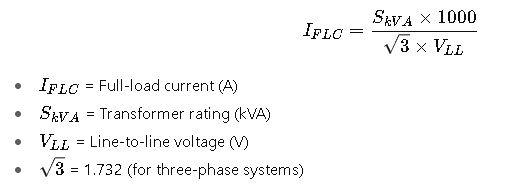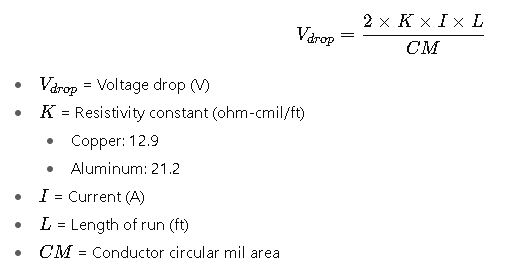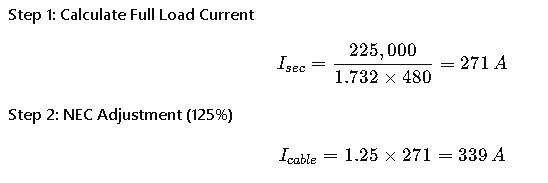Designing and sizing cables for transformers is essential, ensuring compliance, safety, reliability, and reduced voltage drop. This guide provides a detailed reference on transformer cable sizing calculations, including tables, real-world examples, and NEC rules.
Transformer Cable Sizing Calculator — NEC Guidance
Estimates conductor ampacity required for transformer secondary circuits (kVA → A) with common NEC practice.
What formula does this use?
Does it replace NEC tables?
Why 125%?
Why Transformer Cable Sizing Matters
Transformer cables connect primary and secondary windings to distribution systems, switchgear, and protective devices. Selecting the wrong cable size can lead to:
- Excessive heating of conductors.
- Failure to comply with NEC ampacity tables.
- Increased electrical losses and reduced efficiency.
- Higher risk of insulation breakdown.
- Non-compliance with short-circuit withstand capability.
Thus, engineers must carefully apply NEC Article 450 (Transformers), Article 240 (Overcurrent Protection), and Article 310 (Conductors) to determine the correct cable size.
Common Cable Ampacity Values (NEC-Based Reference)
The following table summarizes commonly used copper conductor sizes (75°C insulation, THWN/THHN, in conduit, based on NEC Table 310.16). These values are the foundation for transformer cable sizing calculations.
| Conductor Size (AWG/kcmil) | Ampacity @ 75°C (A) | Typical Application Voltage (V) | Notes |
|---|---|---|---|
| 14 AWG | 20 A | 120 V branch | Rarely used for transformers |
| 12 AWG | 25 A | 120/240 V | Light control circuits |
| 10 AWG | 35 A | 240 V | Small control/auxiliary |
| 8 AWG | 50 A | 240/480 V | Small dry-type transformer |
| 6 AWG | 65 A | 240/480 V | Secondary side ≤ 15 kVA |
| 4 AWG | 85 A | 240/480 V | Secondary side 25–30 kVA |
| 3 AWG | 100 A | 480 V | 30–45 kVA transformers |
| 2 AWG | 115 A | 480 V | 45 kVA secondary |
| 1 AWG | 130 A | 480 V | 45–75 kVA |
| 1/0 AWG | 150 A | 480 V | Common for 75 kVA |
| 2/0 AWG | 175 A | 480 V | 100 kVA secondary |
| 3/0 AWG | 200 A | 480 V | 112.5 kVA |
| 4/0 AWG | 230 A | 480 V | 150 kVA |
| 250 kcmil | 255 A | 480–600 V | 225 kVA |
| 300 kcmil | 285 A | 480–600 V | 250 kVA |
| 350 kcmil | 310 A | 480–600 V | 300 kVA |
| 400 kcmil | 335 A | 480–600 V | 350 kVA |
| 500 kcmil | 380 A | 480–600 V | 500 kVA |
| 600 kcmil | 420 A | 480–600 V | 600 kVA |
| 750 kcmil | 475 A | 480–600 V | 750 kVA |
| 1000 kcmil | 545 A | 480–600 V | 1000 kVA |
These are baseline ampacities. Adjustments must be made for:
- Ambient temperature correction factors.
- Conductor bundling / derating (NEC 310.15).
- Voltage drop requirements (recommended ≤3%).
Fundamental Formulas for Transformer Cable Sizing
Transformer cable sizing relies on a set of core equations. Let’s break them down step by step.
1. Transformer Full Load Current (FLC)

Common transformer FLC values:
- 45 kVA, 480 V → 54 A
- 75 kVA, 480 V → 90 A
- 150 kVA, 480 V → 180 A
2. Minimum Primary Conductor Sizing (NEC 450.3(B))
- NEC requires 125% of rated current for transformer primary protection and conductor sizing.
3. Minimum Secondary Conductor Sizing (NEC 240.21(C))
- Secondary conductors must also be sized at 125% of FLC, unless specific tap rules apply.
4. Voltage Drop Calculation

Recommended limits:
- ≤ 3% for feeders.
- ≤ 5% overall system.
5. Short-Circuit Withstand Check

Expanded Tables: Transformer kVA vs Cable Size (NEC 75°C)
The following table provides direct cable recommendations for common transformer sizes (three-phase, 480 V secondary, copper THWN/THHN, 75°C, NEC-compliant, assuming ≤75 ft run and ≤3% voltage drop).
| Transformer Size (kVA) | Secondary FLC (A) | Min Cable Size (AWG/kcmil) | Typical Primary Protection (OCPD) |
|---|---|---|---|
| 15 kVA | 18 A | #10 AWG | 30 A |
| 30 kVA | 36 A | #8 AWG | 60 A |
| 45 kVA | 54 A | #6 AWG | 70 A |
| 75 kVA | 90 A | #3 AWG | 125 A |
| 112.5 kVA | 135 A | 1/0 AWG | 175 A |
| 150 kVA | 180 A | 3/0 AWG | 225 A |
| 225 kVA | 270 A | 350 kcmil | 350 A |
| 300 kVA | 361 A | 500 kcmil | 450 A |
| 500 kVA | 601 A | Parallel 2×500 kcmil | 800 A |
| 750 kVA | 902 A | Parallel 3×500 kcmil | 1200 A |
| 1000 kVA | 1202 A | Parallel 4×500 kcmil | 1600 A |
Real-World Application Examples
Case Study 1: 75 kVA Transformer, 480 V to 208Y/120 V

Step 3: Select Cable Size
- From NEC Table 310.16 → 300 kcmil copper (285 A @ 75°C).
Step 4: Voltage Drop Check
- Assume 75 ft run, 208 A load.
- Voltage drop < 3% → acceptable.
Recommended cable: 300 kcmil Cu, THWN, with 300 A breaker.
Case Study 2: 225 kVA Transformer, 480 V Secondary

Step 3: Select Cable
- From NEC Table 310.16 → 350 kcmil Cu (310 A) not enough.
- Next size up → 400 kcmil (335 A) still slightly low.
- Final → 500 kcmil (380 A) → compliant.
Step 4: OCPD Selection
- Choose 350 A breaker per NEC 450.3(B).
Recommended cable: 500 kcmil Cu, THWN, with 350 A OCPD.
Temperature Correction Factors for Transformer Cables
Cable ampacity values published in the NEC assume an ambient temperature of 30°C (86°F). However, in real-world installations, ambient temperatures are often higher, especially in electrical rooms, rooftops, or industrial environments. Failure to apply correction factors can result in undersized conductors.
The following table shows typical temperature correction factors for copper conductors rated 75°C and 90°C insulation:
| Ambient Temperature (°C) | Factor (75°C Insulation) | Factor (90°C Insulation) |
|---|---|---|
| 21–25 | 1.08 | 1.05 |
| 26–30 | 1.00 | 1.00 |
| 31–35 | 0.94 | 0.96 |
| 36–40 | 0.88 | 0.91 |
| 41–45 | 0.82 | 0.87 |
| 46–50 | 0.75 | 0.82 |
| 51–55 | 0.67 | 0.76 |
| 56–60 | 0.58 | 0.71 |
For example, if a 500 kcmil conductor has a base ampacity of 380 A at 30°C, and the installation temperature is 45°C, then the effective ampacity is 380 × 0.82 = 311 A. This can drastically change the cable size selection for large transformers.
Conduit Fill and Derating Considerations
Another factor often overlooked is conduit fill. NEC Article 310 requires derating when more than three current-carrying conductors are installed in the same raceway or cable tray.
- 4–6 conductors → 80% of rated ampacity.
- 7–9 conductors → 70% of rated ampacity.
- 10–20 conductors → 50% of rated ampacity.
In transformer applications, parallel runs are common for large kVA units. When running three sets of parallel conductors per phase, conduit sizing and derating rules must be applied rigorously. Engineers must evaluate whether to use multiple conduits with fewer conductors per conduit to minimize derating and improve cooling.
Copper vs. Aluminum Conductors for Transformers
One of the most frequent design decisions is whether to use copper or aluminum cables. Both materials are NEC-approved, but they differ significantly in performance and cost.
| Characteristic | Copper | Aluminum |
|---|---|---|
| Conductivity | Higher (better ampacity per area) | Lower (requires larger size) |
| Weight | Heavier | Lighter (easier to handle in large sizes) |
| Cost | More expensive | 30–50% cheaper |
| Terminations | Less prone to creep | Requires anti-oxidant compound |
| Mechanical Strength | Stronger | Weaker (larger bend radius) |
| Common Use | Critical feeders, short runs | Long feeders, large kVA transformers |
In many projects, engineers choose aluminum conductors for large secondary feeders of 500 kVA and above due to cost savings, while copper conductors are reserved for primary feeders or installations where space, reliability, or mechanical strength are critical.
Practical Design Considerations
When sizing transformer cables, engineers must evaluate several practical conditions beyond ampacity:
- Distance and Voltage Drop
- Runs exceeding 100 feet often require upsizing conductors.
- The NEC does not mandate voltage drop limits, but industry standards recommend ≤3% for feeders and ≤5% overall.
- Short-Circuit Withstand
- Conductors must withstand fault currents for the duration of protective device clearing time.
- Larger kVA transformers with low-impedance ratings can deliver extremely high fault currents.
- Neutral and Grounding Conductors
- For delta-wye transformers, the secondary neutral may need to carry significant harmonic currents, especially in systems with nonlinear loads (computers, drives, LED lighting).
- Grounds must comply with NEC Article 250.
- Parallel Conductor Runs
- For currents above 400 A, parallel runs are common.
- NEC requires that parallel conductors be the same length, size, material, and termination.
- Future Expansion
- Designers often oversize cables to allow for future load growth, avoiding costly upgrades later.
NEC Articles Relevant to Transformer Cable Sizing
- Article 240: Overcurrent Protection – establishes rules for protective devices sizing.
- Article 250: Grounding and Bonding – defines grounding electrode conductors and bonding requirements.
- Article 310: Conductors for General Wiring – primary source for ampacity tables.
- Article 450: Transformers – includes protection and installation requirements.
- Article 310.15(B)(3): Adjustment factors for more than three conductors in a raceway.
- Article 310.16: Ampacity tables for copper and aluminum conductors.
An engineer must reference all these sections when finalizing transformer cable sizing.

